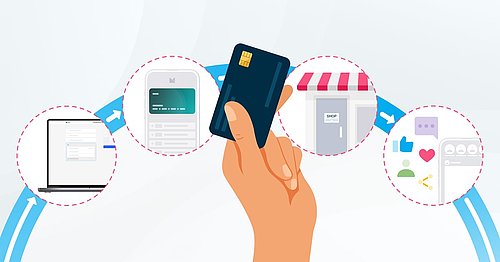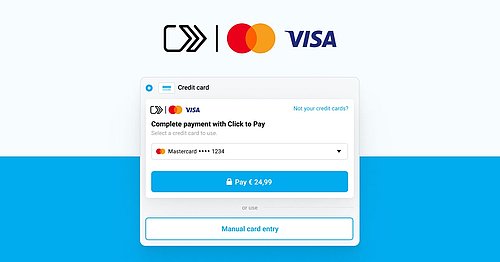What is omnichannel, and why is it essential to build an omnichannel strategy for your business
What does omnichannel mean?
Omnichannel isn't just having many different (physical or online) points of sale. An omnichannel strategy seamlessly integrates all the company's touchpoints (physical shops, webshops, apps, or temporary stores) into a single view. A true omnichannel approach requires a uniform and seamless customer journey, and smooth transitioning from one sales channel to another. In a nutshell, it is as if the customer does not realize that they have looked at an item offline and purchased it online (or vice versa) because all communications, services, benefits, and tools that the company makes available to them are the same and consistent across all channels.
Omnichannel vs. multichannel
To get to the heart of what 'omnichannel' means, we must first make a distinction between omni- and multichannel.
As the word suggests, a multichannel approach also involves selling through multiple distinct channels, but the main difference is that a multichannel setup does not integrate your operations and data into a single channel.
We already said that operating as an omnichannel business means ensuring the continuity of the experience for the customer when switching from one channel to another. Customer data must be shared and updated simultaneously on all platforms to obtain more accurate and detailed profiling. But being omnichannel also means ensuring effective integration between departments (sales, customer service, after-sales, etc.) so that they all contribute to the seamless management of the customer and their purchases. It also means being able to count on reliable, secure, and easy payments in both the physical shop and the online one. Finally, marketing and communication also have a role: the brand image is presented consistently across all touchpoints in an omnichannel strategy. Furthermore, data profiling allows targeted campaigns to be planned according to purchasing behavior.
All elements that a multichannel vision struggles to achieve.
Why adopt an omnichannel approach
Delivering a consistent shopping experience brings many undeniable benefits for those who pursue it and those who use it. We recap them below.
Advantages for merchants
- First and foremost, the chance to profile their customers in a more exact and controlled way, thus being able to collect more data and crucial information for improving and increasing business, such as shopping habits and preferences.
- It also follows that the implementation of an omnichannel strategy allows planning of well-reasoned investments, both in terms of marketing campaigns, identifying the channels on which it is better to focus, and in terms of work distribution and organization of the other departments involved.
- An increase in conversion rate, revenue, and loyalty is inextricably related to a smoother shopping experience and customer satisfaction.
- Also, the brand image benefits from the power of omnichannel: since it is presented consistently across all channels, it helps users become aware of it and builds loyalty
- A multichannel strategy does not involve the interconnection of all the available channels and touchpoints. This means that transactions and customer profiles must be managed in separate processes. In an omnichannel system, on the other hand, everything is integrated into a single process, which provides huge benefits in terms of cost, time savings and efficiency.
Benefits for consumers
- The satisfaction, first of all. Customers who feel supported throughout the purchasing process will return and be more willing to share (on social media, on review portals, and via traditional word-of-mouth) about the positive experience. Creating an omnichannel approach that allows them to quickly 'move' between the different touchpoints and conclude the purchase where and how they prefer will make their life easier and encourage them to spend more.
- Customers will thus benefit also from a faster shopping experience and from further facilitations when switching from one channel to another. For instance, services such as click and collect allow them to choose and buy a product online and pick it up at the physical shop.
The role of payments in a successful omnichannel strategy
An excellent omnichannel strategy also goes through the integrated and unified management of payments.
And this is where we come in. A reliable and expert partner knows how crucial consistency and security are in a successful shopping experience. And the right partner will help you achieve your business goals by supporting your omnichannel strategy, starting with payments. Here's how.
Unified management of data and payments
Regarding payments, the best way to support a merchant's business is to simplify all management and control activities. With MultiSafepay's omnichannel offering, it is not only the end-user who will enjoy a uniform and consistent approach but also the merchant who will have the opportunity to monitor all his payments (physical and online) in a single dashboard. Being able to rely on a single control hub for all activities reduces time and workloads, uses a unique connection for all payment processes in all the touchpoints, and helps to create a more solid and engaging customer journey. Also, through our dashboard, you can obtain more organized profiling of your customers, whatever channel (online or physical) they use for their purchases. In order to achieve this result, the data must of course be made available. The more data is entered into the system, the greater the value from which one benefits.
Wide range of POS solutions
The best way to support flawless and secure shopping experiences at the physical point of sale is by providing your customers with modern, state-of-the-art payment tools.
A complete range of POS terminals must include products for every need and every type of business, from the small family-run shop to the large international chain. It translates into many possibilities, from small hand-held models to stationary ones, to more complex kiosk systems designed for self-service payments. All MultiSafepay terminals have in common that they offer all payment types in the physical shop: magstripe, contactless payments with card and NFC technology, EMV chip, and so on.
MultiSafepay's omnichannel offer also gives room for those who already have their own POS devices or process their online payments with another provider. It is possible to use our payment software without having to buy our terminals and still enjoy benefits.
One single reconciliation process for offline and online transactions
Unified data and payment management allow for a single automatic reconciliation flow for all transactions (both online and at the physical shop). It simplifies administrative business processes and accounting operations (massive increase in time-saving).
Imagine your customer buys a product online but chooses to return it in-store. If your systems are unified, your process will be seamless and the history and refund will automatically be updated and take this into account in all your systems - saving you the manual labor of updating this.
How to build an omnichannel strategy for your business
Considering the topics discussed so far, here is a list of tips for merchants who want to structure an effective and lasting omnichannel strategy:
- Customer data is the starting point: who they are, what their favorite products are, trends in their purchasing behavior, and the channel through which they reach out to the company. Tools such as Google Analytics, social, your dashboard, and in-store surveys can reveal valuable information for the next steps.
- Ensure that all touchpoints are interconnected and that the information customers receive is always consistent offline and online. Whatever the channel, the customer experience must always be the same and of the highest level.
- Facilitate integration (and collaboration) between the company's departments to follow the customer at any stage of the buying process.
- Simplify life by relying on a payment provider that allows single, secure management for online and offline payments.
- Customize messages and communications according to the target audience and channel, bearing in mind that the corporate image must always be consistent.
Successful omnichannel strategies: the example of Vinopremier
An excellent example of an omnichannel business is Vinopremier, to which we have dedicated a case study on our blog. According to CEO Carlos Andonegui, omnichannel is firmly back in business again. And their omnichannel strategy works well because online and offline channels support each other.
The Spanish company is a 'reverse' omnichannel case: Vinopremier first started its own online sales channel, followed by opening several physical shops in Spain and abroad (as other famous examples, Andonegui mentions Amazon or Apple opening physical shops).
The solid strategy on the web has allowed for user loyalty and a substantial increase in sales at the physical stores. For Vinopremier, 80% of sales happen offline. And the e-shop conversion rate has increased by about 40% in the last year.
Extra activities, such as the organization of events and tastings and the opportunity of additional benefits reserved for the most loyal customers, also contribute to this result.
Conclusions
You can easily deduce that creating an omnichannel strategy is no joke. It requires study, planning, and expertise on several levels. Being able to count on the support of reliable partners, especially if they are experts in the sensitive area of payments, is crucial. A partner like this can help you get started and ensure you're hitting all the key points, and that's exactly what our omnichannel offer will help you do.
At MultiSafepay, we believe in the power of omnichannel, and we consider it one of the most relevant trends in the present and future of the ecommerce industry. We have discussed it in our new ebook, which you can download for free at this link.
Ready to start your journey into the world of omnichannel?
Contact us and let's discover what we can achieve together.



